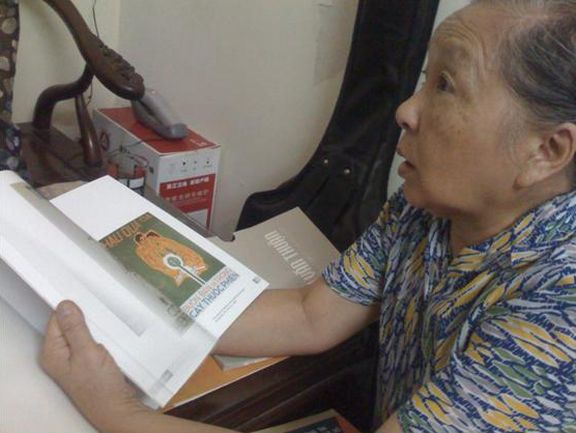Le Lam at his home in Hanoi
Thuc Phi, a propaganda artist and companion of Le Lam
The immediate impression Le Lam gives is of a warm, sprightly, perceptive and ascetic man who belies his almost eighty years of age. He and his artist wife, Ngoc Lan, a 'Cheo' singer, were married in 1957 and they now reside in a studio apartment overlooking a lake in the Thanh Cong district of Hanoi.
Le Lam is widely considered to be Vietnam’s pre-eminent living artist, acclaimed for both his propaganda art and equally for the quite extraordinary range, volume, and quality of his battlefield and campaign illustrations. These works number in the thousands - the results of several decades in the 'field'.
“Protect the people’s sovereignty”, 1968*
Le Lam designed the above poster in 1968 while in Ben Tre Province, a region renowned for the courage of its female fighters and civilian protesters, who are celebrated in art and song (refer to the 'Women in Combat' Gallery).
This poster was painted in 1968, the year of the Tet offensive. A female fighter with a National Liberation Front (NLF) flag attached to a bayoneted AK47, is haloed by a dappled golden light; shell casings are strewn around her feet, and the walls are pockmarked by machine gun bullets.Le Lam was officially selected as the first Vietnamese artist to go to Russia to study the propaganda art technique in 1958. He stayed until 1964, returning to his homeland brimming with ideas and with an enduring love for Botticelli and Renoir.
Le Lam continued to illustrate journals throughout the progressive wars of liberation until the final unification of Vietnam in April 1975.
In the South
Le Lam Volunteered to go to South Vietnam in 1965. He set off on the Truong Son or Ho Chi Minh Trail armed with his brushes, paper, and colours, a young and idealistic revolutionary artist not imagining that he would not see his wife and two children for almost a decade.
The artist had undergone basic training in preparation for the arduous trek south, a journey that in those early days took an average of five to six months to complete. He carried up to 35 plus kilos on pathways that crossed mountains and deep ravines. The journey required one to forge numerous rivers and streams while sleeping rough. Within the Group with which he travelled were two famous musicians and one of the most celebrated male dancers of the age.
Whenever he had the time, Le Lam drew and painted his fellow travelers. He soon became known for his knowledge and love of poetry and song. He knew poetic verse and patriotic works by heart and was considered to have a fine voice. An example from one of his favorite poets, To Huu, is entitled 'Road Sabotage':
“Over the hills
The moon squats, watching.
The road is too long, the holes too shallow.
Deeper, there must be deeper pits.
Spades, shovels, hands, men, women.
The rocks fall, the earth breaks.
Deeper, they must be deeper.
The soil smells rich in the darkness,
The women compete with the men in teams:
Men, women, spades, shovels, hands.
The path curves, winds, twists,
Yet we gash our trenches into its flesh:
Pits for the French when they come this way,
Beds for the French to lie in.
Graves in the land for the enemy of the land”
There were the dangers to be avoided such as detection by enemy guard posts or aerial reconnaissance. This was coupled with ever-present hunger, nighttime chill in the mountains, and the danger of virulent malaria in the valleys and low lands. Le Lam fell victim to the latter and he arrived in the South sick and weakened.
Following his recovery Le Lam soon adapted to local life, which he found so different to that of the North. He travelled to various areas, always painting and mixing with the local inhabitants.
Nguyen Thi Cao courageously confronting American tanks*
Depiction of a dramatic dawn assault on an enemy outpost*
Le Lam speaks of his time in the jungles, rice paddies, and hamlets of South Vietnam with great tenderness. He possesses an unquenchable spirit and idealism that is undiminished by time. He mounted improvised exhibitions for people to see his works, an average of 60 to 70 pictures, sometimes more, which were pegged to lines or displayed in any practicable way possible.
Impromptu showings were continually staged, often at great risk to all concerned. This policy of the dissemination of the revolutionary message was the application of the propaganda strategy refined by General Vo Nguyen Giap. Giap considered propaganda to be an essential element in the War effort that would help create the groundwork to ensure eventual victory.
Le Lam organized clandestine and impromptu wood block printing workshops to produce propaganda leaflets. Sometimes he produced leaflets in English extorting the American GI's to return home.
The artist always travelled with a flute, in one celebrated moment playing to the accompaniment, as it were, of the sound of artillery in the near distance, while forging a river in the company of pretty courier girls.
A favorite story told by Le Lam is based around his love of Cai Luong, a form of Vietnamese opera widespread and popular in the South. During the Vietnam-American War, Lam normally sang Northern songs, but one day his companions asked him to sing a Cai Luong song they knew he liked. He stood and readied himself, but the instant he began to sing B52 bombs started to fall all around him. This was never forgotten by his comrades and in jest he was forbidden by them ever to try to sing Cai Luong again.
- Richard di San Marzano-
Le Lam conducting a drawing class for VC fighters in the South in 1971.*
* Images courtesy of the artist






